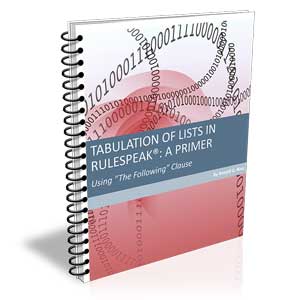The Problems Addressed by Business Rules: Foreword to Business Rules: Management and Execution
Excerpted from the new book just released: Business Rules: Management and Execution https://www.amazon.com/dp/0986321486
Business rules cover a very broad space. Across the entire space, however, you can be sure about one central idea — business logic should not be buried in procedural programming languages. Call it rule independence.
Why is rule independence important to you? Because rules entangled in procedural code won't ever be agile. Rules change all the time — and in a digital world the pace of change is always accelerating. How you can stay on top of it is the central question in business agility.
That's not to say business logic is simple. Just the opposite. It can often be quite complex. So why entangle it in procedures and code, which must attend to all sorts of other complex concerns, ranging from platforming, messaging, synchronization, data access, user interfaces, and more? Why mix them up?!
So, business rules are all about disentanglement — a natural separation of concerns. What advantages does that have? For one thing, you can involve subject matter experts directly in the validation and verification of the business logic before it is implemented. For another, you can often empower the business side to make changes directly to the business logic after deployment. In other words, you can give a degree of control back to the business side — and in the process, free up IT resources for other work.
Let's not forget about compliance. Often, compliance people are among the strongest supporters of the business rule approach. Why? Because with business rules, results can be directly traceable. If someone (such as a business partner or regulator) wants to know why a business result was produced, instead of program code or (usually sparse) documentation, you can inspect the actual business rules that produced the results. Fast, efficient, trustworthy.
To understand all the areas that business rules cover requires looking at the things that business processes must (or should) address.
- Decisions. Suppose you want dynamic pricing, taking into account multiple factors about the customer, the product, current demand and supply, size of the order, etc. What better way to organize the business logic than as a set of rules?! You can analyze the structure of the decision using an appropriate decision model, then express the rules in some decision table(s) with clear outcomes. Recognizing that decisions are a separable part of process models has been one of the most important contributions of the business rule approach.
- Case Management. Businesses often organize activities around concepts that have predictable stages or states. A classic example is the medical case of a patient. The same thinking, however, pops up in a great many situations — for example, products developed in stages, orders that progress through predictable states, complaints, inquiries, break-downs, purchases, etc. What better way to coordinate allowable movement between states or stages than by explicit rules expressing what constraints must be satisfied?! Managing cases effectively as a distinct aspect of processes would prove difficult or impossible without rules.
- Data quality. If you want high data quality, it must reflect business results produced correctly in the first place. Business rules help ensure that happens by guiding business behavior. Think about it this way: Processes only ensure you do the correct things; business rules ensure you do those things correctly. So, business rules always play either a direct or an indirect role in data quality matters — there's no way to escape it. Business rules give the prominent profile to data quality matters absent in processes alone.
- Digitalization. Even in today's world, many gaps remain in processes where manual intervention is still required, sometimes as basic as simply moving data from one form or format to another. In the past few years, robotic process automation (RPA) has stepped up to this challenge by offering effective rule-based solutions.
Not everything business rules address, however, is so easily cast into a pure-process perspective. Nor should it be. Consider these areas:
- Requirements. Analysts and developers face several key challenges. One is ensuring that models are robust and complete. Put simply, diagrams are just diagrams without rules. Another is user stories. It's been said that user stories represent merely the tip of the iceberg with respect to requirements. What's the other 90%? A significant percentage is business rules.
- Communication. In a day and age when IT is so central to running business, it's simply unacceptable that communication gaps still exist between the business side and IT. How can these gaps be closed in a manner that does full service to the complexity and richness of what business people know in their heads? And to the vocabulary they use to talk about it? Business rules.
- Knowledge Retention. In traditional companies, retirement of key subject matter experts is a hard reality. In newer companies, the turn-over rate of workers is unprecedented. How do you capture core knowledge in such form that it is not lost when workers walk out the door? Business rules.
In thinking about all these areas that business rules address, it's hard to escape the insight that business rules are a pure form of explicit knowledge. They shape business behavior and guide decisions — independently of (but in cooperation with) procedures and platforms. What else could they be but pure business knowledge?
In a day and age when machine learning (ML) and AI are all the rage, it's fair to ask why business rules still matter. Will ML and AI make business rules obsolete? If not, where is the dividing line between them?
There's no doubt that we're just at the beginning of a wild and exciting ride for how machines will address knowledge. In certain respects, however, the shape of things to come is already clear. And the answer is no, ML and AI will not make business rules obsolete. Let me explain why.
Today's ML capabilities are purely statistical. In fact, that's the very reason for the unbelievable progress AI has made over the last decade — the realization that many problems do not actually require symbolic representation (think words). A bot driving a car does not need to explain why it didn't hit a pedestrian — it just needs not to hit them. A bot listening to my voice commands does not need to explain why it 'knows' it's talking to me — it just needs to be sure it's me. A bot playing a game of chess or Go does not need to explain its moves — it just needs to win.
And that brings us to the bottom line for business rules — they always tell you why. Whenever humans are in the loop — and there are explicit laws and obligations and rules to worry about — you'll always need to know why. That's what business rules are ultimately about — the why.
I could go on, but enough about the ideas behind business rules and their role in the industry. I'm pretty sure you're reading this book to find out what world-class practitioners have actually achieved in their businesses with business rules. So, let's get to it!
You're going to be hugely impressed by the range of industries and problem spaces addressed by the case studies in this book. I know I am. I've gotten all sorts of new ideas from them — and I'm sure you will too. Enjoy!
# # #
About our Contributor:
Online Interactive Training Series
In response to a great many requests, Business Rule Solutions now offers at-a-distance learning options. No travel, no backlogs, no hassles. Same great instructors, but with schedules, content and pricing designed to meet the special needs of busy professionals.











How to Define Business Terms in Plain English: A Primer
How to Use DecisionSpeak™ and Question Charts (Q-Charts™)
Decision Tables - A Primer: How to Use TableSpeak™
Tabulation of Lists in RuleSpeak®: A Primer - Using "The Following" Clause
Business Agility Manifesto
Business Rules Manifesto
Business Motivation Model
Decision Vocabulary
[Download]
[Download]
Semantics of Business Vocabulary and Business Rules